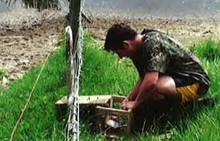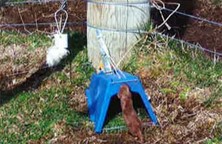Not often seen but always present, cats, ferrets, stoats and weasels are the most destructive predators to waterfowl populations, but rats and hedgehogs also have an impact. Having food and ideal habitat available at your pond attracts ducks, which in turn will attract larger predators such as cats and mustelids. This is why predator control is important and should be done to increase the survival rate of birds using your wetland.
Most predators have preferred habitat that they like to hunt so knowing your enemy can give you an advantage and increase you trapping success.
| Range | Habitat | Traps | Bait | Trap Locations | |
| Cats | 30-400ha | Dry areas with cover often near water (rivers/ ponds), derelict buildings/sheds. | Timms, cage, leg hold. | Rabbit, Hare. |
Fence lines, in/ near structures, habitat changes, fresh rabbit burrows. |
| Ferrets | 30-70ha | Forest edge, pastoral open country near waterways. |
DOC 250, Possum master, cage. |
Rabbit, Hare, Egg. | Fence lines, in/ near structures, habitat changes, fresh rabbit burrows. |
| Stoats | 60-200ha | Forest edge, pastoral open country near waterways. | DOC 250, Possum master, cage. | Rabbit, Hare, Egg. | Fence lines, in/ near structure, habitat changes. |
| Weasels | 10-30ha | Forest edge, pastoral open country near waterways. | DOC 200, Possum master, cage. | Rabbit, Hare, Egg. | Fence lines, in/ near structure, habitat changes. |
| Rats | 4-6ha | Forest edge, areas near water (rivers, ponds, lakes, estuaries). |
DOC 200, Victor rat trap, bait stations. |
Rabbit, Hare, Egg, Peanut butter. | Fence lines, in/ near structure, habitat changes. |
Feral Cats
It is estimated that feral and domesticated cats kill up to 100 million birds in New Zealand each year. If ducks were to make up only 0.5% of those birds killed then cats would be killing around 500,000 game birds - each year!

Cages are more expensive but worth the cost.
Ferrets
Often revisit previous kill sites, so to increase your chances set traps at these sites when you find them. Rub scent of previous kills around the trap to attract others.
Stoats
Are strong swimmers and have crossed open water of up to 1.5km. Stoats are considered to be one of the most destructive predators of birds in New Zealand.
Norway Rats
Grow up to 40cm with a shaggy appearance, commonly known as water rats. They often have well worn runs connecting feeding areas with burrows.
Where to trap
Most predators generally like to stay dry and· close to cover but will establish tracks so set traps along these. Trap lines should follow changes in habitat e.g. the edge between long and short grass and the edge of a pond. Other prime locations are ridges, tracks, creeks, shelterbelts, fence lines, hay barns and culverts.

A fence line, habitat change and close to water, an ideal spot for this DOC trap.
There is a large variety of traps with the following recommended:
Kill traps
- Possum masters (noose trap)
- Timms
- Fenn
- DOC 200/250 traps (set in wooden box)
Live capture traps
(must be checked daily)
- Leg hold traps
- Cage traps
- Box treadle trap
A variety of traps can be purchased from rural supply stores, with many subsidised by some regional councils. It is a good idea to use a variety of traps as some predators may be trap shy to a certain type of trap.

Timms work well for a range of pests including this stoat.
Bait
Fresh, natural bait works best - eggs, fish, cat food, commercial dehydrated baits, and rabbit and hare meat all work well. Visit traps regularly to remove what you have caught and to freshen up the baits. Use a variety of baits as some will be more effective on different species. Poisons and dispensers are readily available at most rural stores.
Trapping should be constant and intensive. Once trapping stops predator numbers can quickly return to pre-trapping levels.
Traps may not catch immediately, but do not move them. Predators will be visiting your traps on their rounds and may make many visits until they decide they are "safe". Often a cool change in the weather encourages predators to take the extra food on offer. Perseverance is the key to trapping predators.
Scuffing up fresh soil in front of the traps can increase interest as it mimics rabbit activity. Placing traps near rabbit droppings can also be effective.
Get stuck in and stop these pests killing your ducks!

The Possum Master. if used on the ground instead of vertical on a tree, makes it more versatile and will trap other pests such as this weasel.